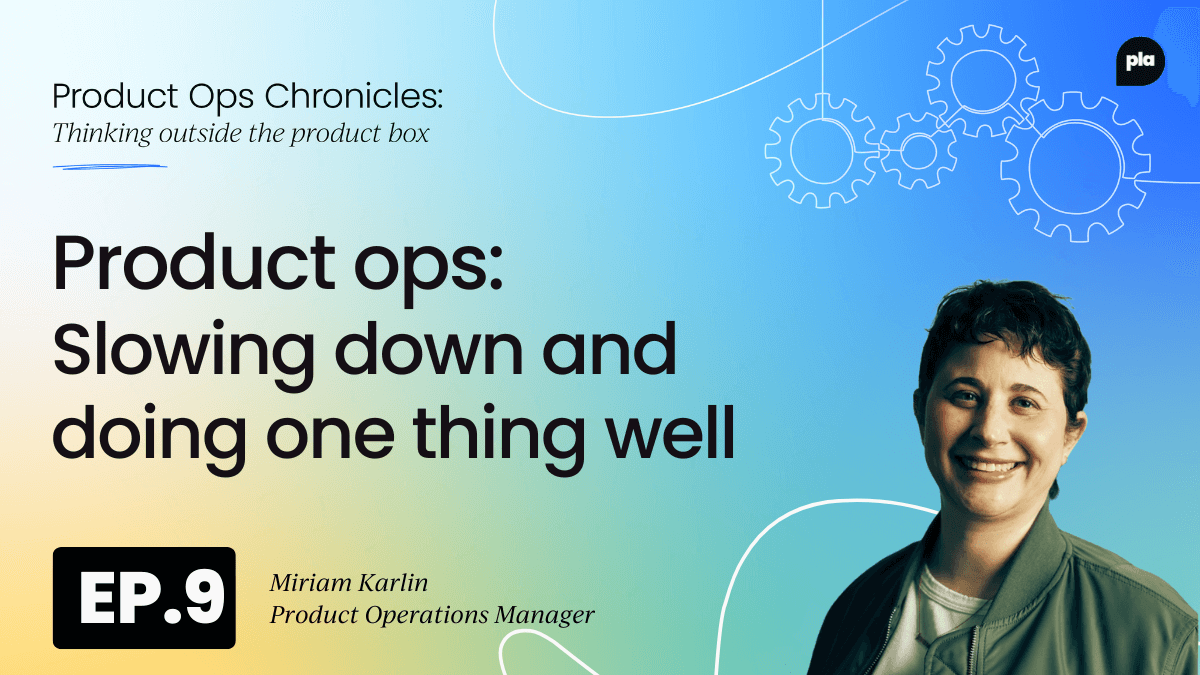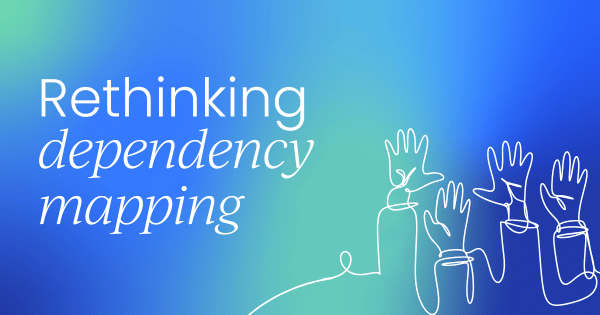Dependency mapping needs to change
Prioritization and dependency mapping aren’t new concepts, but they’ve become pressure points for product teams everywhere. And not in a theoretical way — in the real, roll-up-your-sleeves-and-wrestle-with-it way that leaves everyone drained after every quarter.
Every three months, teams dive headfirst into a week of brutal planning. It’s painful, it’s messy, and it usually gets shelved the moment the dust settles.
Then three months later, it starts all over again.
Sound familiar? This is the reality for a lot of orgs right now.
And it’s not just the work itself — it’s the weight of it.
The pain isn’t just in the doing, but in the fact that no one’s really cracked how to make it stick. There’s a growing realization that prioritization and dependency management have to evolve.
We’re not just planning features anymore — we’re expected to explain impact. How does this affect the business? What did it move? What changed for our users?
Prioritization and dependency work isn’t going away — it’s getting more complex, more visible, and more tied to real business impact. And if we want to keep up, we need a smarter, more flexible way to deal with it.
Why prioritization problems are often people problems
When prioritization breaks down, most people look to process. They assume the framework's wrong, the timeline’s off, or the inputs aren’t clear enough.
But that’s rarely the core issue. In our experience, most prioritization problems are people problems.
A lot of the pushback that surfaces in planning conversations isn’t resistance to the idea itself — it’s just people being maxed out.
They’re not stonewalling, they’re overwhelmed. There’s no headspace left.
The problem isn't the plan — it’s that no one has the bandwidth to even think about the plan.
It’s not that teams don’t want to collaborate or contribute. It’s that they literally can’t. When everyone’s already stretched to 120%, even the idea of adding one more decision, one more meeting, or one more initiative becomes too much. People check out, not because they don’t care, but because they’re overloaded.
And here's where things get even more complicated — many orgs operate under the myth that "the teams will work it out." There's this built-in assumption that folks will naturally collaborate, that if something comes up, people will just get on a call, hash it out, and move forward. But in reality? That rarely happens.
Most teams aren’t structured — or supported — to “just work it out.” The bandwidth’s not there. The psychological safety might not be there. And the systems often don’t encourage it. What looks like reluctance is often just self-preservation. “I can’t take on your thing, because I’m already drowning in mine.”
This is why product ops can't just be about tooling and process. It has to be about people — their behaviors, their habits, and how those get shaped over time. If your system doesn’t make it easier for people to connect, make decisions, and protect their cognitive load, then it’s not going to work.
At its core, prioritization is about trade-offs. And trade-offs require trust, shared context, and headspace. No framework in the world can fix that. That’s why operational excellence starts with understanding human behavior — and designing around it.

Dependencies don’t need to slow you down
In fast-growing companies, there’s often a deliberate blind spot when it comes to dependencies.
Leaders don’t want to talk about them. And they definitely don’t want to formalize them.
The fear is always the same: “It’s going to slow us down.” There’s this almost religious belief that people should just work it out on their own — no forms, no friction, no fuss.
But that mindset creates a trap.
Because eventually, as things scale, the dependencies don’t go away — they multiply. And when there’s no system in place, teams start building their own.
That’s when product ops folks often step in to create a process. But here’s where it backfires.
What often gets built is a rigid, front-loaded system that forces teams to predict needs months in advance. And it doesn’t work.
The process turns into a poorly designed game — teams inflate their asks, lock in time on other teams’ calendars before they even know what they need, and everyone gets boxed into fake certainty.
That same company, a few years later, hits a more stable growth phase. Suddenly, those once-ignored dependencies are everywhere — and slowing everything down.
The reaction? Overcorrect.
The org jumps straight to heavyweight frameworks like SAFe. But now the problem isn’t chaos — it’s institutionalized incoherence.
Endless meetings. Layers of abstraction. And still no clarity.
The truth is, most companies don’t need exhaustive dependency spreadsheets or headcount forecasts by week. They need alignment.
Sometimes it’s as simple as saying, “Hey, we’re not sure what’s coming, but we’re going to need a close partnership on this.” That’s it. No 18-tab workbook, just a shared understanding that collaboration is required.
Trying to track 11% of Mary’s time, or squeeze 4% more out of Mark doesn’t solve anything. It just creates noise. The smarter move is to design a system that supports the reality of how teams actually work — messy, adaptive, and always in motion.
Good dependency mapping doesn’t block progress. It removes friction. And that starts with getting honest about what’s really slowing you down.

Gaining cross-functional alignment
Most alignment problems don’t start in meetings or Miro boards — they start with behavior.
The way people respond, the decisions they make (or avoid), the little signals they send in Slack threads or calendar declines. That’s where the real action is.
And that’s why gaining alignment across functions is way more psychological than procedural.
A big part of product ops is stepping back and asking: How did we end up here?
Why did that team make that call? Why did someone ghost that follow-up? Why are we suddenly clashing over something that should’ve been easy?
More often than not, the root cause isn’t a missing doc or misaligned OKRs. It’s the human stuff.
The assumptions, habits, and defense mechanisms that silently shape how people behave. And if you don’t take time to unpack that, you’ll keep treating symptoms instead of solving the actual problem.
Take your product operations knowledge to the next level.
Our Product Operations Certified: Masters course can help you bring new ideas, tools, and thinking to the table. All while having a tangible impact on your teams performance.
The certification is designed to help you solve real problems your company faces as soon as you complete the material.
So... what are you waiting for? Start impressing your boss today.
One dynamic that comes up constantly is this weird split between unrecognized effort and silent rejection.
On one hand, you’ve got people quietly helping behind the scenes — spending 30% of their time supporting others, jumping into fire drills, giving context — without ever getting credit for it.
On the other, you’ve got folks ignoring requests altogether, just letting them die in inboxes, because their work feels more urgent. Neither gets addressed. Both become part of the culture.
And here's the thing: a lot of that’s invisible. Teams aren’t broadcasting their help, and they’re not announcing their disengagement either. From the outside, it looks like disconnection.
But underneath, there's a tangle of quiet collaboration and quiet refusal — and no one’s really sure what’s going on.
For product ops, that’s the challenge. You can’t just map dependencies and run rituals — you have to understand the why behind the behaviors. Why aren’t people showing up to that sync? Why did this team go rogue on a decision? Why does one department always seem out of the loop?
Once you start to see the patterns, alignment becomes less about forcing people into a process, and more about designing for how they actually work.
Recognizing the helping behaviors, making them visible. Surfacing the blockers, and dealing with them honestly.
Because alignment isn’t just agreement; it’s trust, timing, and clarity. And you don’t get there by adding more slides. You get there by decoding the behavior underneath the process.

5 practical steps for dependency mapping
Dependency management doesn’t need to be all-encompassing. The real goal is to create clarity and space so teams can move faster with fewer collisions.
Here are five simple but effective ways to make that happen:
- Start by clearing the clutter. Look for work that could be transactional but has become overly collaborative. Automate it, template it, or simplify it to free up team capacity.
- Align funding with team reality. Not every team operates the same way. Some need flexible exploration, others need structured delivery. Match funding and expectations to the team’s “growth stage”.
- Track independence and alignment. Use one guiding metric: how many of your teams are reasonably independent and aligned? If that number drops, it’s time to intervene.
- Design for different team types. Teams have different shapes — platforms, features, and infrastructure. Treat their dependency needs differently instead of forcing a one-size-fits-all process.
- Make space the goal. Any dependency process should reduce noise and cognitive load. If it’s adding more work, it’s probably not working. Optimize for bandwidth, not bureaucracy.

Final Thoughts
Dependency mapping and prioritization aren’t just process issues — they’re people issues. The real blockers usually come down to overloaded teams, unclear expectations, and missing alignment.
If your system doesn’t make it easier for people to engage, it won’t matter how well it’s designed.
Sometimes it’s better to stop asking “why” and just start doing.
Shift the behavior first. Create small wins that show teams what good can look like. Change happens when people feel it, not when they hear about it.
Product ops lives in the tension between vision and reality. You need both. But instead of getting stuck in “we just need to...” or “but what if...,” focus on what you can actually do now.
Start small, stay clear, and keep moving.




 Follow us on LinkedIn
Follow us on LinkedIn








